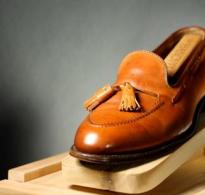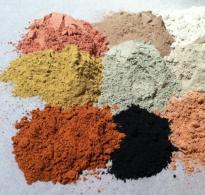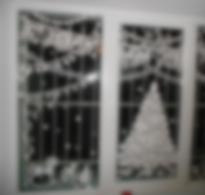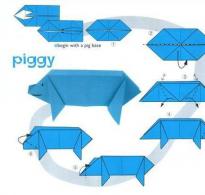Chicken from bags step by step. Rooster made from plastic bottles: master class with photos and videos. Roosters embroidered with cross stitch, beads and ribbons
To create together with your child, you can use any material at hand. A mother can invite her child to make crafts from plastic bags, of which there are sufficient quantities in any apartment.
At first glance, it seems that making crafts from garbage bags is easy, but this is not so. A 3-year-old child may not be able to do everything, for example, knitted crafts from garbage bags. Therefore, it is most preferable to offer this type of creativity to a child over 7 years old. Younger children can create animal crafts using garbage bags.
To create a rabbit, you need to prepare the following materials:
- two cardboard rings with a slot inside;
- scissors;
- plastic bags;
- thick thread;
- three beads – eyes and nose.
- Let's prepare the pom-poms. First we make long strips from a plastic bag and tie them together. Cut out two circles from cardboard with a slot inside.
- We begin to wrap cardboard rings in a circle.
- If the strip is over, then cut off the ring at the root.
- Place the next strip.
- We wrap the strips in a circle until the cardboard ring is completely closed.
- We cut off the resulting workpiece with scissors.
- We stretch a strong thread between the two rings and tighten it.
- Remove the cardboard circles and straighten the resulting pompom.
- We make the second pompom in the same way.
- We connect the remaining ends of the threads from both pompoms. The result is a head and torso.
- We make rabbit ears from a strip no more than 3 cm wide as follows: twist the strip twice in the middle.
- Fold the strip in half and straighten it out.
- We tie it just below the middle.
- Glue on the ears, beady eyes and nose.
- We make paws and legs from small pompoms and glue them on. The rabbit is ready.








You can make other animals in a similar way by varying the color scheme of the bags.
Method for creating balls from plastic bagsTo make it easier to make crafts from bags, you must first make skeins.
- We take a bag with handles and fold it like an accordion along its entire length.
- Cut off the bottom and handles.
- Cut the bag crosswise into pieces.
- We unwind the resulting pieces and connect them into a single thread.
- We wind it into balls.

There are a huge number of ways to cut plastic bags: spirally, diagonally, lengthwise, crosswise, etc.
Crafts from cellophane bags: master classOn the eve of the New Year, you can invite your child to create a Christmas tree as a craft from bags with their own hands, which can be given to someone close, for example, to a grandmother. It is necessary to prepare the following materials:
- ruler with circle stencils of various diameters;
- compass;
- a simple pencil;
- green plastic bags;
- scissors;
- scotch;
- threads;
- needle;
- beads or glass beads;
- White paper;
- ball pen;
- flat button.

If you take several multi-colored garbage bags, you can make a Christmas tree like this:

By creating crafts from bags, you develop not only creative thinking, but also creative abilities. This kind of crafts can be done together with older children. This will teach them that a work of art can be created from any available and, at first glance, seemingly unnecessary material.
Without a second thought, we throw a plastic milk carton into the trash. And such a fate awaits millions of packages, except those that fall into the hands of Rimma Marfonova from Krichev. She creates a real fairy tale from seemingly waste material.
Will need: plastic milk bags, scissors, empty plastic containers (for example, for shampoos), colored PET bottles, wire, heat gun.
Yarn preparation
To make polyethylene threads, I cut off the upper narrow edge of each bag. I washed it thoroughly with dishwashing detergent on the outside and, after turning it inside out, inside. Dried it. I started cutting the tape from the open edge of the bag at a slight angle (photo 1). I cut it in a circle with a single strip about 1 cm wide until the end of the package (photo 2). I prepared all the other packages in the same way. I connected the blanks together by tying them in a knot (photo 3), which I hid on the wrong side of the product when knitting. For convenience, I wound the ribbon into a ball.Polyethylene knitting
I started knitting with a loop (knot). I formed it on my fingers. To do this, I held the working thread in my left palm, leaving about 20 cm of free space, and brought the tape over the middle finger. I stepped back 5 cm from the edge of the thread and secured it between my thumb and forefinger, thus forming a loop (photo 4). She inserted three fingers of her right hand into it, twisted it clockwise (photo 5), hooked it with her index finger and pulled the working thread through the loop (photo 6). She pulled the ends and tightened the knot. Then she inserted a hook into it and began to knit. Depending on the intended figure, I used various basic elements - an air loop, a half-double crochet, a single crochet and a double crochet. This knitting is similar to the amigurumi technique*. Garden figurine "Cockerel"
Garden figurine "Cockerel"
Master of the yard
The body of the cockerel was knitted, starting from the tail. Knitted 5 ch. (photo 7), closed them in a ring. Next I spoke in circular rows st. b/n. Having constructed a schematic pattern, I divided the figure into segments, and when knitting them, I added and subtracted sts as needed. I left a small hole on the head and tightly filled the workpiece with plastic bags.On a note
If the figure is large, you can use bags as stuffing, distributing them inside closer to the knitted fabric, and filling the center with foam. With such a filler, your “sculpture” will not be afraid of either rain or snow.
Then she continued knitting, decreasing stitches until she was left alone. Fixed the tape. Fastening the new thread on the body of the cockerel in the right places, I tied the comb, earrings, beak, and then similarly at the bottom of the body - the legs (legs). I twisted the paws out of wire and fixed them in the shins with a heat gun. I glued my eyes. For the bright wings, neck and tail I used colored plastic bottles and containers. I cut out blanks in the shape of feathers from them and, for greater realism, I cut the edge of the parts (photo 8). Glued it to a knitted base using a heat gun. I painted the head fragments with red enamel.
Using this knitting technique, I decorated my area with decorative figures (photo 9-13).

Recorded by Alina Avdeeva.
Photo by Irina Savosina
*Amigurumi is the Japanese art of knitting or crocheting all kinds of small animals, people, as well as inanimate objects, all the details of which are knitted in the round without seams with dense fabric.
There probably isn't a person who doesn't use packages. But few people know that they make various cool trinkets. It’s very easy to make crafts from plastic bags with your own hands, and plus you won’t incur additional costs.
You can create tricks from plastic bags with your own hands quite quickly. Moreover, you will not incur any special costs or efforts when making trinkets.
Step-by-step instructions for making a flower:
It is necessary to fold the polyethylene so that it becomes a square. Next, cut the coals so that you get petals. The next thing you need to do is fasten all the pieces together with wire. Instead of the middle, use a bead or a beautiful button.
Diagram of a polyethylene flower
All you need is a piercing and bags. First, twist the wire into a circle and secure it well. Next, you need to tie the cut strips around the frame. It is advisable to attach more of these strips, then the wreath will be thicker and brighter. You can add other trinkets: an artificial skull, rubber spiders, etc.
A few examples of photos on how you can diversify your Halloween wreath:

Thanks to this technology, you can quickly and easily make beautiful wreaths from bags for Christmas or Easter with your own hands. It all depends on how you want the wreath on your door to look. We present to your attention a video in which you can learn in detail what needs to be done and why.
To work you will need:
- Packages, preferably green.
- Scissors. Manicures are possible.
- Beads for the future foundation.
- Needle and thread.
- Compass.
The technology for making a Christmas tree from plastic bags is quite simple:
- First, make some preparations. It is necessary to cut circles from the bags. You will need to prepare circles of different diameters, since several of them will go to the top and middle of the tree, and the larger ones will go to the bottom.
- It is advisable to very carefully stretch the edges of your circles a little. Do this very slowly so as not to damage the workpiece.
- Take two identical circles and glue them together. By the way, you need to insert another circle between them, but with a smaller diameter. Having completed this process with all the blanks, you can begin assembling our Christmas tree.
- The rings need to be folded from top to bottom, from the largest to the smaller ones.
- We begin to assemble our tree in the following way: we put a circle on a needle, and then a bead, then everything again and so on until the very top. Instead of the top, you can use beads or some other decoration that you like best.
In the photo the Christmas tree looks like this:

Christmas tree made from bags
You must have:
- Multi-colored, bright bags. Preferably 3-5 shades.
- There are two types of wire: thick and thinner.
- Sheet of paper – 2 pcs. A pen or pencil to draw a sketch.
- Thermal gun.
The manufacturing process begins with a drawn frame of the cockerel’s body, along which the body of our figurine will need to be bent using thick wire. Next, you need to cut strips from the bags, preferably 3 cm long for the sheepskin coat and 2 cm long for the head. We take a wire that is thinner and put our blanks on it. Thus, we should have an accordion. We recommend tying the strips tightly, so the finished toy will look more beautiful.
We need to give the rooster volume. To do this, you can use cotton wool or rags, whatever. Having wrapped the fillings and the frame with tape, we proceed to decorating the toy with our colored accordions. It is advisable to attach them using a heat gun. We do everything gradually, there is no need to rush. The comb and mouth can be cut out of plastic or cardboard, at your discretion. When you completely cover the body with accordions, do not forget about the eyes for the animal. These can be simple beads. That's all, the cockerel is ready.

You can make a jump rope for your child from plastic bags with your own hands. You will need to carefully cut thin strips and tie them together. In place of the handles, you can wrap electrical tape or adhesive tape.
There is also a technology for knitting polyethylene, which can be used to make unique handbags or even carpets. It all depends on desire. You can make different pom-poms.
And finally, I would like to note that handmade crafts made from plastic bags will work well as a gift for your children or friends. Don't be afraid to learn something new.
We hope, thanks to our article and master classes, you will soon have at least one polyethylene toy that you made yourself.
Not a single yard in the village can do without such a bird as a rooster. In this article we want to tell you how to make a magnificent rooster from plastic bottles with your own hands.
Let's go to the lesson
The process of making a proud cockerel can be traced using the example of a master class. The step-by-step creation of a cockerel is described in detail and shown in the photo.

In order to make a cockerel, take a canister (volume 5 liters), a plastic bottle (volume five liters), a couple of plastic bottles for the legs (volume one and a half liters), a metal-plastic pipe, scissors, a screwdriver, a stationery knife, self-tapping screws.
The photo shows a model of the body of a cockerel.

In order to fasten the product, you need to use self-tapping screws. They can be purchased at specialized construction stores. The length of the small screws is about one and a half cm, and the large ones are five to six cm. We will use the small ones to fasten the feathers, and the large ones to attach the head.

The first step we will make is the frame of the cockerel. To do this, we move the upper part of the canister by three cm. Then we shape the legs of the metal-plastic pipe. In our case, the cockerel will walk, so one leg moves forward. You need to secure it with self-tapping screws to the canister. In order to make the cockerel's neck, we fold the envelope and attach the screws. Then we cut out the hams from small bottles and attach them to the canister with self-tapping screws. This is how the body turns out:

In order to make the feathers of the cockerel, we will use beer bottles (the shape is shown in the photo). It is necessary to cut off the long neck and cut the bottle into five parts. It is best to navigate along the bottom. We will only use the top part.

Now we move on to the process of pasting the body. You need to start working from the feet. To make it more convenient, you can detach them from the body. Attach crepe paper to the neck of the bottle, and then use wire to attach the feathers.

After we have made the cockerel's legs, we attach them to the body again.

Well, now we’ll just cover the body with feathers, starting from the back. It is necessary to cover all parts except the back with feathers. It is also necessary to leave the back of the cockerel's neck open. As mentioned above, the feathers must be attached to small self-tapping screws.

Then we need to make the paws. Take copper wire (two and a half mm thick). You can take any other wire that bends, but not steel. We bend the shape of the legs from this wire. Then we take corrugated paper and create a leather effect. The tail that remains must be inserted between the corrugated paper and the metal-plastic pipe. To prevent anything from slipping out, seal the bottom with glue for strength.

Then take the bottom of the bottle and cut claws out of it. The claws should be as narrow and long as possible, as shown in the photo. Using instant glue we attach them to the legs.

Use regular spray paint to paint the body and legs of the cockerel.

Cut out the head of a cockerel from construction foam. We use a utility knife to ensure that the cuts are as sharp as possible.
If things aren't going smoothly for you, then you can cut out all the pieces separately and then glue them together with glue.

This is what happens at this stage:

The second photo also shows the cockerel's head:

And third, but from a new angle:

This shape was made using medium-hard sandpaper.

We cover the surface of the head with acrylic putty or any other. Then we need to wait until it dries completely and only then process the head again until it is perfectly smooth. The next step is to treat the surface using regular PVA glue. This is necessary so that the paint adheres well in the future.

Use acrylic paints (or any other) to decorate the cockerel's head. Then we glue the eyes. You can make them yourself, or you can buy them in a specialized store. The next step is to prepare the shape of the wings and then cut them out using side cutters.

We fasten the long feathers of the wing using ordinary wire, the back should still remain open.

You can close the top using corrugated bottles. The last row should go inside the wing, on the bend.

We cover the surface with paint and wait until the product dries. Then we attach the wings to the body and prepare the mesh for the tail. The longer the mesh, the more magnificent the ponytail.

The tail feathers must be cut from 2.5 or two liter bottles. Now we need to paint each feather in two parts.

Attach the feathers to the tail. They can be cut in half.

From transparent bottles we cut feathers of different lengths for the back. Their width is about two and a half cm. We attach them to the body with self-tapping screws, several at a time. Don't forget to paint it yellow.

Here's what happens:

The last row of feathers must be glued so that the screws are not visible.
Apply yellow paint to this part of the work and let it dry.

Add a couple of bright stripes.

We cover the product with transparent varnish (possibly glossy). So the cockerel is ready, which will bring a joyful mood to everyone.

Video on the topic of the article
We invite you to watch a selection of colorful video tutorials on how to make a beautiful rooster from plastic bottles with your own hands.
Elena Kovtun
Waste is a common problem for humanity. Every person contributes to this problem, and everyone must take part in solving it.

Teacher of the first qualification category Kovtun E. I.
Target: make extraordinary things out of ordinary objects.
Tasks:
Show how to work with plastic bags using the example of making a scarf;
Show interest in creativity;
Description of work:
Waste is a common problem for humanity. Every person contributes to this problem, and everyone must take part in solving it. If we give a second life to household waste, we will save our planet from pollution. An example of this is making crafts from waste material for Mother's Day chick costume cape and cape.
Necessary materials and tools:

- yellow plastic bags.
Red paper.
Scissors
Ruler
Pencil or pen
Stapler.
Step-by-step manufacturing process.
The first thing you need to start working with is to prepare the foundation. Trimming square plastic bag. Such blanks need to be cut according to the children's count.


We cut out strips from cardboard and fasten them with a stapler.


We place our scarf on a cardboard strip and fasten it with glue or a stapler.






We also prepare a cape. Here you go The chicken costume is ready.
Publications on the topic:
A very apt statement about the profession of a music director was published in an article by A.I. Burenina in the magazine “Musical Director”.
To work you will need: 1. A pair of crazy pens; 2. Cones; 3. Green gouache paints, brushes; 4. Tinsel; 5. Vata; 6. Plasticine; 7. Colored cardboard;.
DIY photo frameA photo frame is the simplest thing you can do with your own hands - minimum cost, minimum time and maximum.
Master class “DIY New Year's ball” The most long-awaited and beloved holiday, New Year, is ahead. Take part in preparing for this.
The New Year holidays are quickly approaching, and this remaining time is filled with creative bustle: making a variety of things.
Drawing is a favorite activity of children attending preschool. Using unconventional drawing methods.
I really love doing creative things with children. New Years is soon. The most important attribute of the holiday is a snowflake. What would New Year be without snowflakes?






